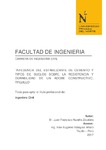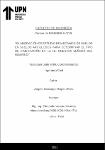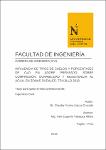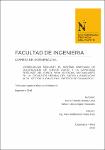Mostrar el registro sencillo del ítem
Influencia del estabilizante de cemento y tipos de suelos sobre la resistencia y durabilidad de un adobe constructivo, Trujillo
| dc.contributor.advisor | Vásquez Alfaro, Iván Eugenio | |
| dc.contributor.author | Nureña Zavaleta, Juan Francisco | |
| dc.date.accessioned | 2017-10-04T00:54:46Z | |
| dc.date.available | 2017-10-04T00:54:46Z | |
| dc.date.issued | 2017-09-04 | |
| dc.identifier.citation | Nureña, J. F. (2017). Influencia del estabilizante de cemento y tipos de suelos sobre la resistencia y durabilidad de un adobe constructivo, Trujillo (Tesis de licenciatura). Repositorio de la Universidad Privada del Norte. Recuperado de https://hdl.handle.net/11537/11168 | es_PE |
| dc.identifier.other | 624.18 NURE 2017 | es_PE |
| dc.identifier.uri | https://hdl.handle.net/11537/11168 | |
| dc.description.abstract | RESUMEN En el presente trabajo de investigación, se evaluó la influencia del estabilizante de cemento y tipos de suelos en adobes constructivos sobre su resistencia a la compresión en condiciones de equilibrio, saturadas con agua, y su durabilidad. El porcentaje de cemento es de: 0%, 3%, 6%, 9% y 12% del total del suelo para la elaboración de unidades de adobe; el tipo de suelo se consiguió al variar la arena y arcilla en 3 proporciones distintas: la primera entre 55 - 70% de arena y 45 - 30% de limos - arcilla, parámetros de la norma técnica de edificación (NTE) E.080; la segunda proporción de 50% de arena y 50% de limos – arcilla; y la tercera proporción de 75% de arena y 25% de limos – arcilla. Las dimensiones del adobe son: ancho 12.5 cm, alto 8.5 cm y largo 21.5 cm. Previo al análisis de la materia prima y el conformado de adobes, se hizo una evaluación de los adobes ubicados en la zona de Trujillo. Los adobes de la investigación fueron elaborados mediante un conformado manual aplicando un buen moldeo para que los resultados no se vieran afectados por el proceso de elaboración. El tiempo de secado fue de 27 días, donde estuvieron almacenados bajo cubierta. Los resultados más óptimos de la investigación son obtenidos a una estabilización de 12% de cemento con una proporción de 75% de arena y 25% de limos – arcilla por encima de lo especificado por la NTE E.080_2006 y NTE E.080_2017, con 48.2 kg/cm por compresión en condiciones de equilibrio y 26.2 kg/cm 2 2 por compresión con saturación de agua por 24 horas. Se pudo observar que la mejor combinación de tierra para un adobe sin la necesidad de usar el cemento como estabilizante es 50% de arena y 50% de limos - arcilla dando un valor de 25.7 kg/cm en condiciones de equilibrio ya que en estado saturado se deshizo. Todos los adobes estabilizados con cemento tienen buena respuesta de durabilidad a la presencia 2 de agua de manera estática frente a un adobe común, puesto que al transcurso de 7 días sumergidos en ella solo los adicionados al 3% fueron afectados en su forma y peso al perder entre 18.1 – 30.3% de material siendo el más afectado el suelo con mayor cantidad de finos en su estructura, sin embargo a partir del 6% de cemento no hay pérdida de peso, es más estos aumentan ligeramente su peso inicial entre 0.1 – 2.4%. Cabe indicar que los adobes constructivos sin cemento se llegaron a deshacer en cuestión de horas. Finalmente se ha puesto de manifiesto que la adición de cemento como estabilizante mejora las resistencias mecánicas del adobe y su durabilidad a partir de un 6%. Aun cuando los suelos inicialmente no puedan ser utilizados para la elaboración de adobe, se puede mejorar su comportamiento mecánico mediante la adición de arena, alcanzando al menos un porcentaje del 50% de la misma y siempre que el contenido de arcilla sea el adecuado. | es_PE |
| dc.description.abstract | ABSTRACT In the present research, were evaluated the influence of the cement’s stabilization and soil’s types in constructive adobes on their resistance to compression under equilibrium conditions, saturated with water, and their durability. The percentage of cement is: 0%, 3%, 6%, 9% and 12% of the total soil for the production of adobe units; the soil type was able to vary the sand and clay in 3 different proportions: the first between 55 - 70% of sand and 45 - 30% of silt - clay, parameters of the technical norm of construction (NTE) E.080; the second proportion of 50% sand and 50% silt - clay; And the third proportion of 75% of sand and 25% of silt - clay. The dimensions of the adobe are: width 12.5 cm, height 8.5 cm and length 21.5 cm. Before the analysis of the raw material and the formation of adobes, an evaluation of the adobes located in the area of Trujillo. The adobes of the research were elaborated by means of a manual forming applying a good molding so that the results were not affected by the elaboration process. The drying time was 27 days, where they were stored under cover. The best results of the research are obtained a stabilization of 12% of cement with a proportion of 75% of sand and 25% of silt - clay above that specified by the NTE E.080, with 48.2 kg/cm by compression at equilibrium conditions and 26.2 kg/cm by compression with water saturation for 24 hours. 2 It can be seen that the best combination of soil for an adobe without the need to use the cement as a stabilizer is 50% sand and 50% silt - clay giving a value of 25.7 kg/cm under equilibrium conditions since in a saturated state it was broken. 2 All stabilized adobes with cement have a good durability response to the presence of water in a static manner compared to a common adobe, since during the course of 7 days immersed in it only those added to 3% were affected in their shape and weight on losing Between 18.1 - 30.3% of material being the most affected the soil with more fines in its structure, however from 6% cement there is no weight loss, it is more these slightly increase their initial weight between 0.1 - 2.4%. It is possible to indicate that the adobes constructive without cement were undone in a matter of hours. Finally it has been shown that the addition of cement as a stabilizer improves the mechanical strength of the adobe and its durability from 6%. Although soils cannot initially be used for the production of adobe, their mechanical behavior can be improved by the addition of sand, reaching at least 50% of the same and provided that the clay content is adequate. | es_PE |
| dc.description.uri | Tesis | es_PE |
| dc.format | application/pdf | es_PE |
| dc.format | application/msword | es_PE |
| dc.language.iso | spa | es_PE |
| dc.publisher | Universidad Privada del Norte | es_PE |
| dc.rights | info:eu-repo/semantics/openAccess | es_PE |
| dc.rights | Atribución-NoComercial-CompartirIgual 3.0 Estados Unidos de América | es_PE |
| dc.rights.uri | https://creativecommons.org/licenses/by-nc-sa/3.0/us/ | * |
| dc.source | Universidad Privada del Norte | es_PE |
| dc.source | Repositorio Institucional - UPN | es_PE |
| dc.subject | Materiales de construcción | es_PE |
| dc.subject | Suelos | es_PE |
| dc.subject | Resistencia de materiales | es_PE |
| dc.title | Influencia del estabilizante de cemento y tipos de suelos sobre la resistencia y durabilidad de un adobe constructivo, Trujillo | es_PE |
| dc.type | info:eu-repo/semantics/bachelorThesis | es_PE |
| thesis.degree.grantor | Universidad Privada del Norte. Facultad de Ingeniería | es_PE |
| thesis.degree.level | Título Profesional | es_PE |
| thesis.degree.discipline | Ingeniería Civil | es_PE |
| thesis.degree.name | Ingeniero Civil | es_PE |
| dc.publisher.country | PE | es_PE |
| dc.subject.ocde | https://purl.org/pe-repo/ocde/ford#2.01.01 | es_PE |
| thesis.degree.program | Pregrado | es_PE |
| dc.description.sede | Trujillo San Isidro | es_PE |
| renati.advisor.dni | 80524374 | |
| renati.advisor.orcid | https://orcid.org/0000-0002-6717-0501 | es_PE |
| renati.author.dni | 71224530 | |
| renati.discipline | 732016 | es_PE |
| renati.juror | Vásquez Díaz, Alberto | |
| renati.juror | Villar Quiroz, Josualdo | |
| renati.juror | Aguilar Villena, Roxana | |
| renati.level | https://purl.org/pe-repo/renati/level#tituloProfesional | es_PE |
| renati.type | https://purl.org/pe-repo/renati/type#tesis | es_PE |
Ficheros en el ítem
Este ítem aparece en la(s) siguiente(s) colección(ones)
-
Tesis [1439]







